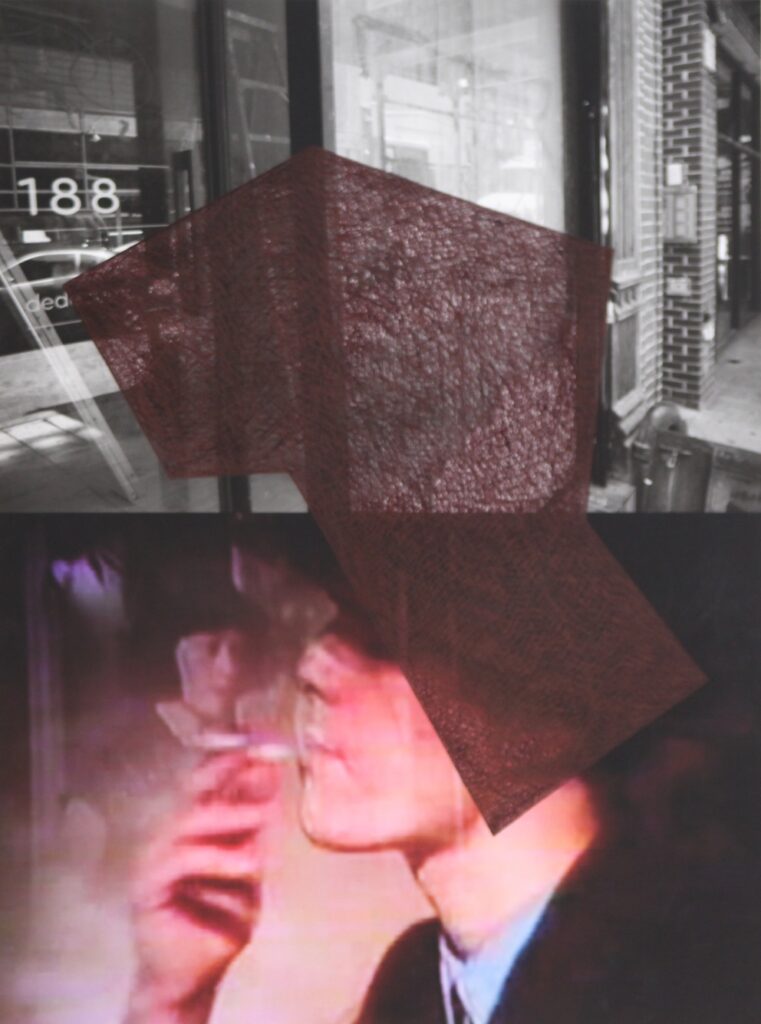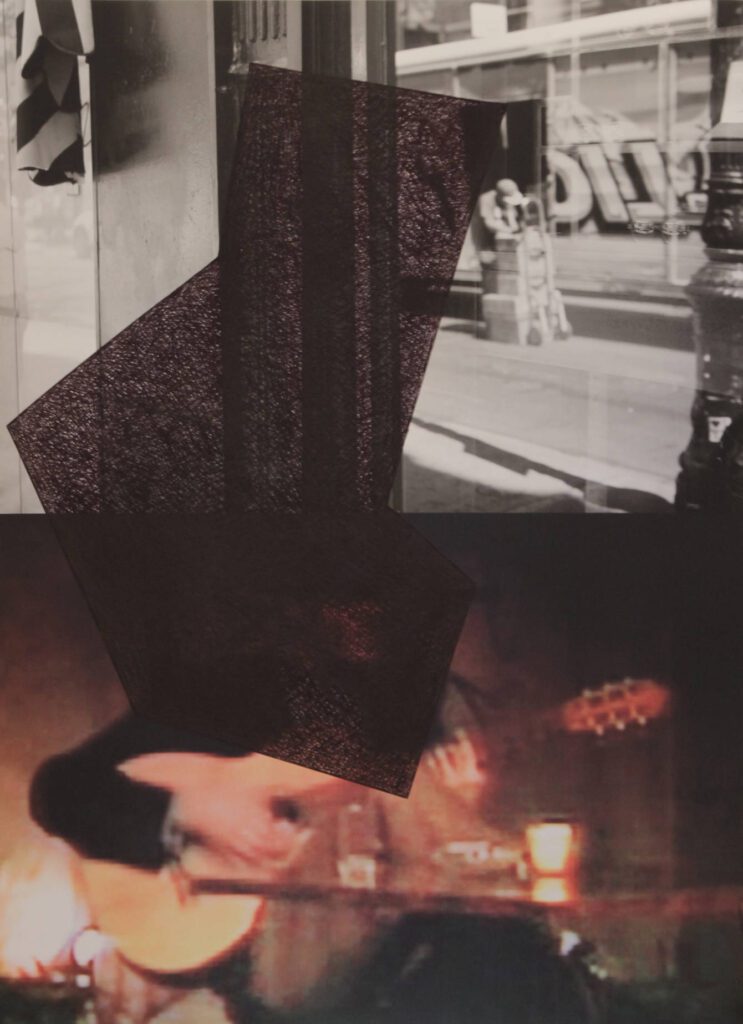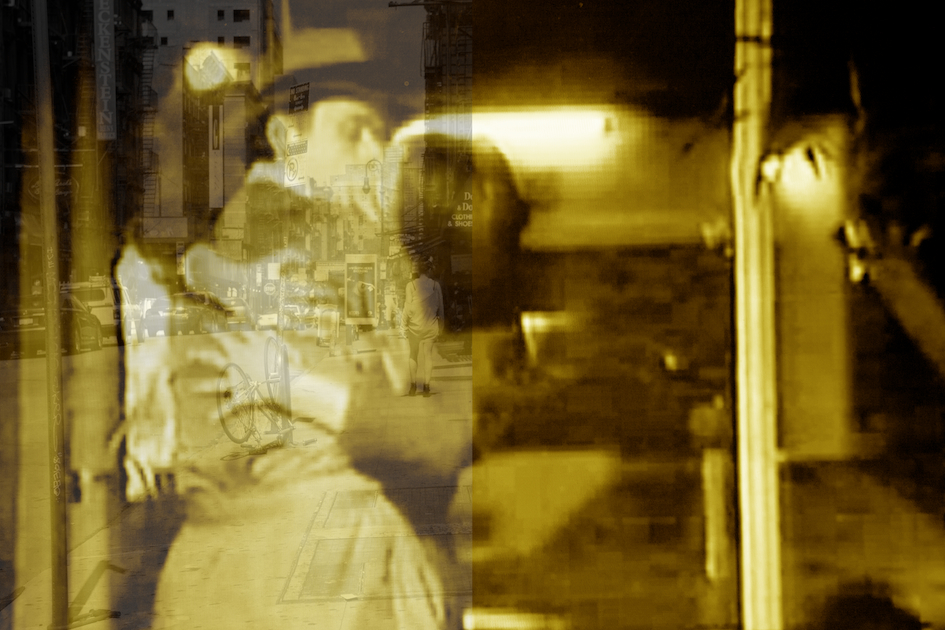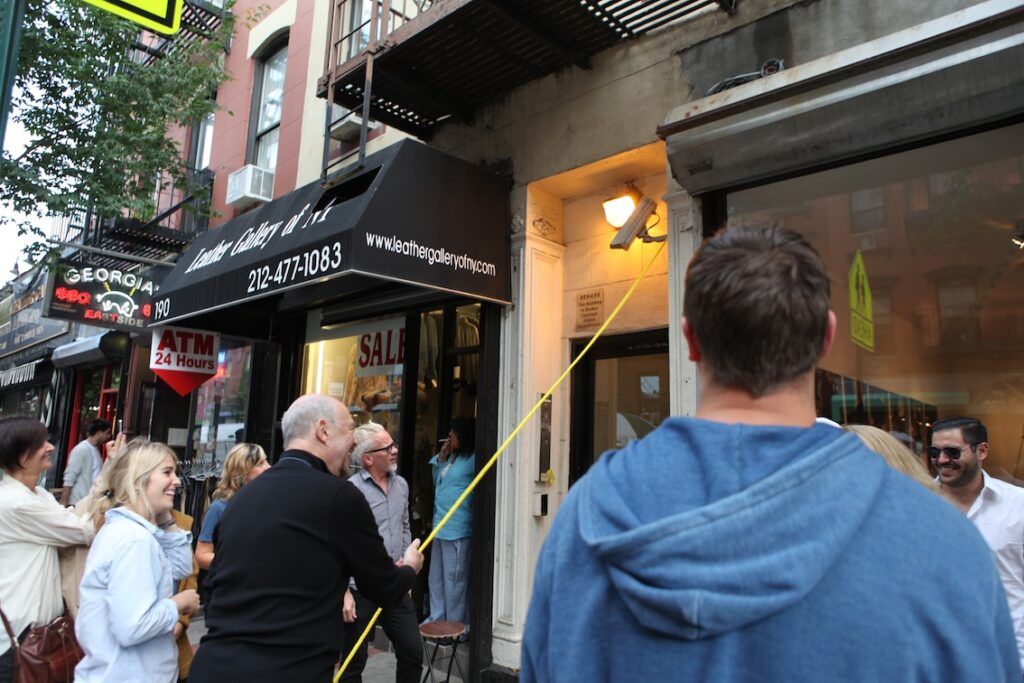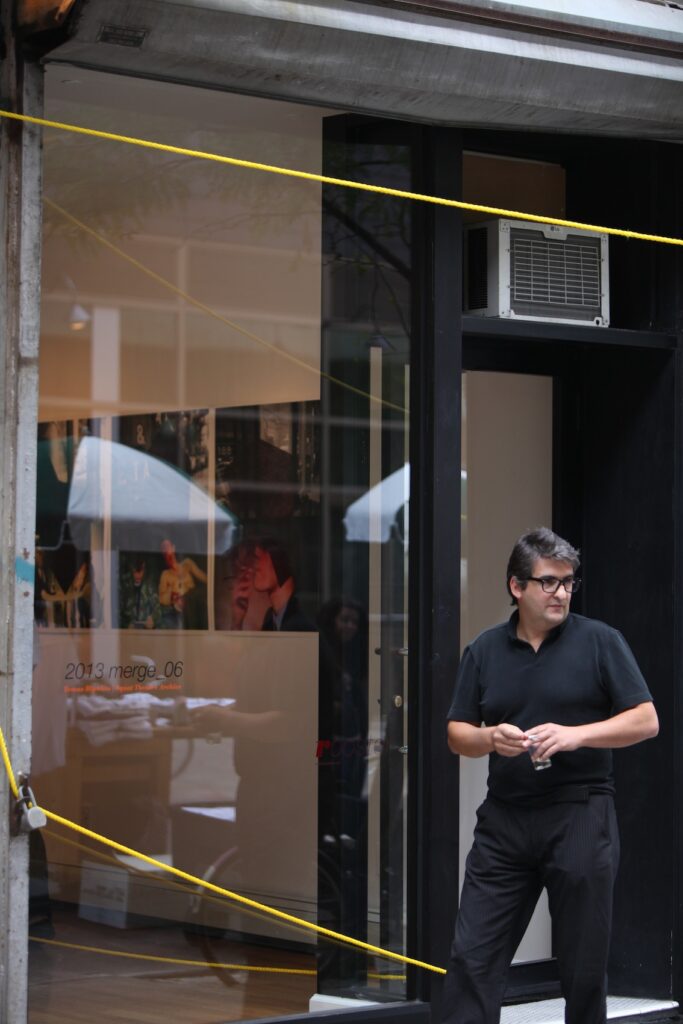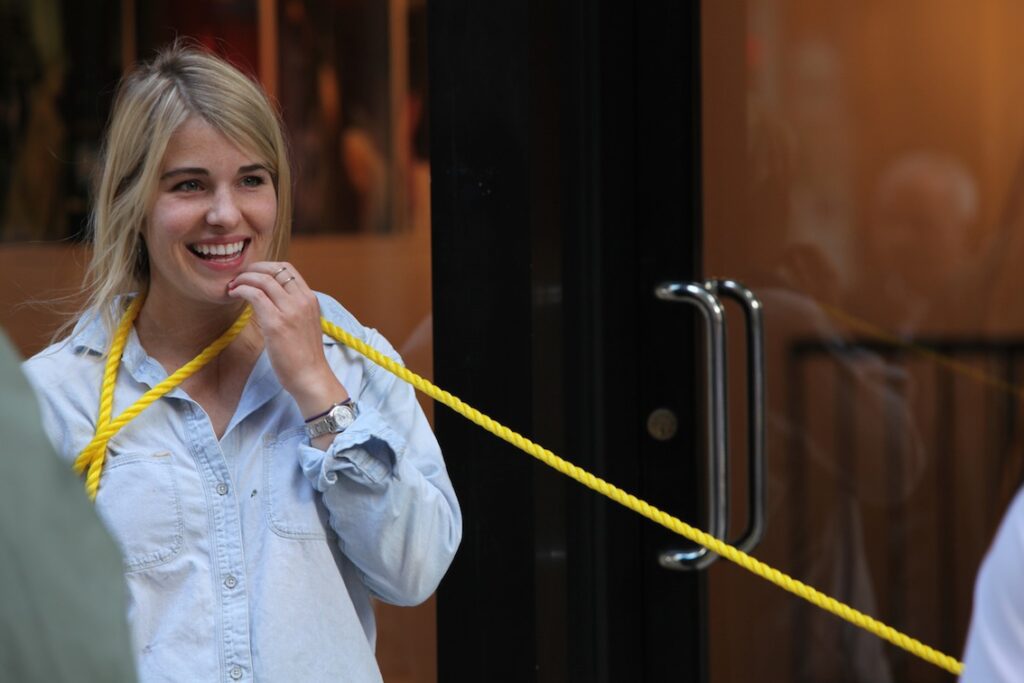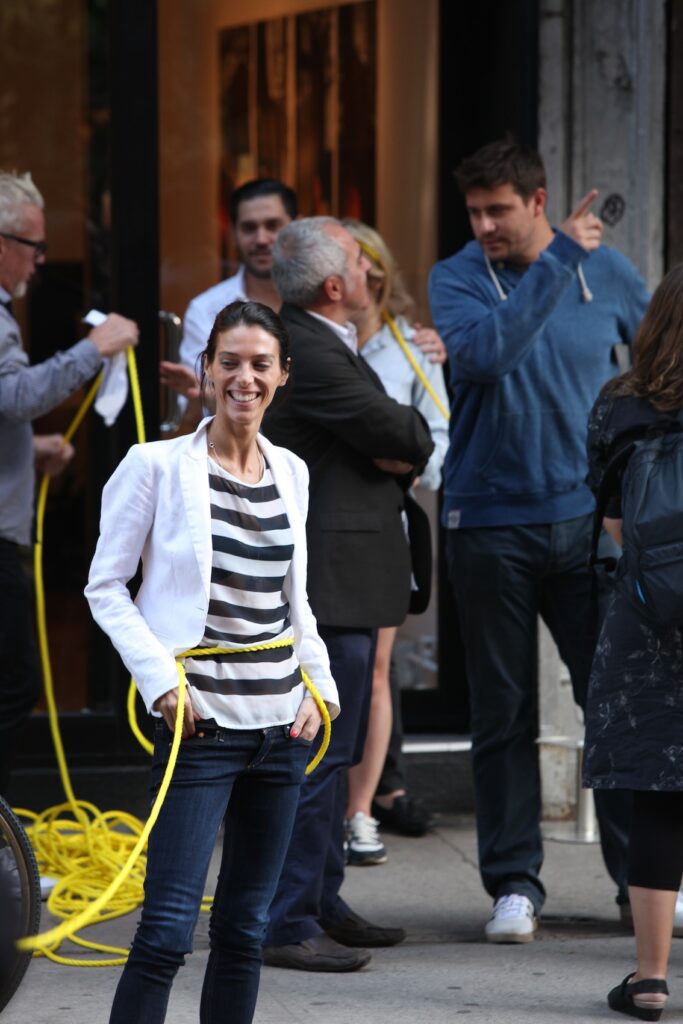2013 merge_06 | Rooster Gallery | NY
text related2013 merge_06 Rooster Gallery, NY
In “2013 merge_06” Tomaz Hipólito (b.1969, Lisbon) follows his obsession with notions of space, whether physical, personal or historical. With the concept of vital space as background, Hipólito’s work is an ongoing research, driven by what the artist called “mapping gesture.”
The title of the exhibition clearly indicates the artist’s need for mapping. By using preexistent coordinates, Hipólito creates a new territory, which situates itself between reality and experience. This so-called “interval” is where the artist’s core themes are exhaustively revisited, and begin with the staging and investigation, revealing methods through which we apprehend the relations between persona, object and space.
Archives have in recent years gained a privileged position as a point of access to previous artistic experiences. By delving into Squat Theatre’s Archive, the artist’s intent was not to rescue the artistic practice of this experimental theater group – whose actions have remained in New York’s underground mythology and in the memory of those who had the chance to see them live – but rather to reuse it according to his own needs. Thus, Hipólito brings light to their practice while using it as a means to his own researches, which encompass some of the group’s issues.
Squat Theatre can trace its origins to Budapest in the late 1960s. Initially known as Kassak Studio, its members renamed the group after being expelled from Hungary due to their avant-garde and radical practice. After creating and touring with their first storefront play in Western Europe for more than a year, they permanently relocated to New York City in 1977.
From then on and until 1985 their activity would take place at 256 West 23rd Street, between 7th and 8th Avenues. Its members lived and performed in a building on the same block with one of New York’s artistic Meccas, the Chelsea Hotel. Although the actual building no longer exists – having been replaced by a cinema complex – Squat Theatre’s plays and performances were intimately connected to the space where they were taking place. Playing with the inside and the outside or the public and the private sphere, Squat’s performances were able to blur several frontiers, namely the role of the intervening and the non-intervening parties and the perception of space. A storefront would never be a storefront again after being converted into the scenography of politically and poetically charged plays.
By comprising multiple media, such as photography, film, video, painting, drawing and performance, Tomaz Hipólito intervenes in the aforementioned “interval.” It is fair to believe that Rooster’s premises become a new territory, the interval itself, in an ambiguous game between past and present.
Therefore, in “2013 merge_06” Hipólito operates in and with Time and Space the same way Squat Theatre did, blurring frontiers and continuously challenging the viewer’s perceptions of lived-memory and built-memory.
2013 Lisbon André Escarameia
2013 merge_06 Rooster Gallery, NY
SQUAT THEATRE – PIG!CHILD!FIRE
I
1978, October. First trip to the United States of America. Non-stop flight Lisbon/New York.
Wrapped up in the bags was the idea of a mythical New York avant-garde, magnet of other worlds
that we got through magazines, movies, paintings, music, a universe idealized with militancy in
Salazar’s Portugal where memory does not move forward and the sterile past drummed to a single
beat, a single color; well-packed were the Pop imaginary and the fantasy of a festive and secret,
anti-familiar underground, a place par excellence to screen the experience of the shadow side, a
source of creativity, anxious to take risks, to grow autonomously. In my wallet I carried (besides the
beautiful dollars) the inebriating revolutionary energy of the post-25th of April, an inexperienced
explosion of the recently acquired democratic freedom in the country of oblivion, throwing the doors
wide open to the party of desire with an outlived expiration date taste to it; struggling to recover time
squandered in a sleepy tardy privilege.
New York was the home of Portuguese friends.
One, who was the son of a diplomat who lived on East End Avenue, a student and a rocker,
controlled the music scene; the B52’s (while falling to the sound of Rock Lobster, Bernardo would
make cheesy eye contact with Kate Pierson, who according to him would return the look) and
James White and The Blacks (Ginger Lee would terrorize the dance floor while passing through)
performed at 77 White Street (which would later become the Mudd Club); Devo at the Bottom Lone;
Patti Smith (Leonor Pinhão wrote an article about the concert in the Expresso newspaper) and an
unknown British band, the Police, at the CBGB; Bill Aswell at the Hurrah; the Talking Heads at the
Alexandre Hall in Princeton (seating in one of the front rows, (Mar)Tina Weymouth would take
polaroids of the crowd), and the luxury of the etc…
The other one, a dilettante heiress from Madeira, an artist of self-image, was an habitué of the
downtown bohemian and artistic scene, clubs, bars, parties, and revealed the loft concept to the
Lisbon gang, Vera, Pinconé, and later on Lucas, Pinhão and Jotta. Kinkas lived in the loft of the
German artist YoYo, who regularly recorded the different outlines of the illuminated windows in the
World Trade Center. There, dead from jet lag and after a nocturnal tour in Tribeca, I slept on the first
day; then Joaquim de Almeida, who was studying at the Lee Strasberg Theatre Institute, lent me his
apartment on Lispenard until I ended up at the 23rd Street YMCA, half homeless shelter, half student
hostel. The environments through which I circulated announced a day-after aesthetic yet to arrive,
industrial, threatening and highly seductive, exiguous and squalid access stairs, open freight
elevators, the largeness of the spaces dilated consciousness. One wanted to live at all costs in what
had once been a factory, paint the face, be part of that tribe, of those rituals, be special without a
shadow of a doubt, and an accomplice to all clarity. Feverish imaginary of the amateur with a heart,
disorderly pulsating in the mouth, aware that somewhere out there is a dimension for the exercise of
desire that has been under control for so long. Amazed I understood what the living artistic “scene”
was: emanations of raw energy, undistinguished angels and demons, creations of the here and now,
intertwined and independent one from the others, originated in a continuous flux of inevitable
production of modernity, like a cell in infinite division.
24 hours a day furnished with novelties and with the novelty of what one knew without knowing,
flash after flash. Playground without classes, unique toys glittering at arm’s reach, daily celebration
as if all days were my birthday or Christmas. Glimpsing celebrities on the street. POP everywhere in
tune with the scale. Furious tourism in the mornings and afternoons, museums, bookstores
(Gertrude Stein as mother queen of the letters), cafes (cheese cake – pasty delight, taking the mouth
by storm without letting go), walks on foot and by car (incursion to the depressed Harlem in the
security of the Cadillac, closed windows and locked doors, we venture with the offensive and
morbid curiosity of the voyeur, not without taking back angry spits every time we were forced to
stop) and shopping (the artsy clothing from Parachute in SOHO; the kinky-electro-retro-Ska-Punk
delirium at Patricia Field, the disco-glam at Fiorucci; neon-coloured sneakers displayed on endless
shelves scattered around the city).
The nights were full of intense urban circulation (it helped to park at ease with the diplomatic plate),
stylish toilettes for the kicks, to not go unnoticed in the nocturnal culture en vogue, weird people
with weird lives… (Studio 54, Steve Rubell allows us in the moment that, upon noticing the carnival
of the crowd at the door, we were about to bounce – inside, Ancient Rome revisited).
Cinema on my own: Dune Buddies by Jack de Veau.
One smoked from morning to night.
Amazed, for the first time at the Empire; to climb to the viewpoint at nightfall (Dominique Sanda
among the onlookers finally seemed susceptible to emotion)… Major Tom to ground control…
The Statue of Liberty in the distance. Nocturnal temptation of crossing central Park. Diana Ross live
and in hologram (changed dress as one changes their gait) at the Radio City Music Hall: imagine the
entrance of the public in a palace that is a theater in a way similar to that of a stadium. The revelation
of the existence of a black mainstream class that is more chic, more exciting than the white.
II
Here we arrive at Squat Theatre. How I got there is a mystery even to myself. Maybe the fact that I
was a recently graduated actor might have helped, or should I rather say (un)trained in the absence
of a technique, curious and eager for a present in which I could finally recognize myself? A question
of having a good nose for counterculture? Might it have happened that one day, upon leaving the
youth hostel, I noticed by chance that there was a club in front of it where plays were taking place?
(next to it, the Chelsea Hotel was just another exceptional building, and nothing beyond that, Sid
Vicious had not yet performed his bloody solo act). Did anyone recommend it as the “ultimate trend”
of “what’s hip”? Did I read the add by chance in the Soho News and immediately thought that was
what I was looking for? But what was I looking for? Or was it through a suggestive poster outside
Untitled on Prince? Did I buy the ticket before or at the time of the show? Did they have an open
ticket office? Did they have a ticket office at all? How much did it cost? What language did they
speak? Did they speak? Did they have a program, a libretto? If so, did I buy it? Were they offering it?
Did I lose it? Where did I go after the performance? Was I able to process the amount of images and
emotions… during, after, immediately after, until now, here? Yes, after the initiation in the quality of
being an expatriate, I did a shy handful of plays and performances in the 80s… Peep Show, Dançai
Todos, Mac&Beth, Tetaro…
The 1968 staging by Victor Garcia of Le Cimetière des Voitures by Arrabal had already been seen in
Cascais, coming from Brazil by the hand of Rute Escobar, in a disused warehouse with cars coming
in and out and motorcycles speeding in the gallery, the first avant-garde show in Salazar’s Portugal
of the old, which left the placid public “from the backwoods” speechless… suspicious! Also in the
60s Merce Cunningham wandered on stage in a bicycle and thanked between jeers and passionate
bravos. In 77, the Warsaw Studio Theatre had an uncomfortable presence at the Gulbenkian
Foundation with an apocalyptic version on the human condition. In 76 the commercial movie
theatres showed Morrissey/D’Alessandro/Warhol’s movies, which we saw with our eyes wide open.
Around this time Deep Throat was the first porn movie to take clandestine crowds of embarrassed
men to the cinema, escaping domestic sexuality, screening sessions full of testosterone that broke
barriers between the public and the private.
Let’s go back to Squat Theatre, which built in sketches a fiction without an apparent storyline,
without the personalized mark of a defined author, a marriage in permanent divorce, creating a
tentacular cohesive collective in order to blur the lines between the actor, obliged to be an actuating
element, and the character condemned to be a character, abolishing the fourth wall and the possible
manipulation to which it is prone when serving the political power (Broadway, sic). Thrown out of
communist Hungary, Squat were naturally affiliated with the noteworthy American fracturing masters,
Jack Smith, John Vacarro, Julian Beck, Carolee Schneemann, Richard Foreman, etc., rooted in the
urgency of their time. In our century, the so-called innovative, experimental, alternative theater still
treads this path, with its tongue out. It was the beginning for me, right then and there.
The organic presence of the actors on scene (or was it at home?) was simply the result of a daily
routine, like taking a shower every day (did they really take a shower every day?), or waking up and
eating breakfast (maybe just some of them), a routine that included late at night (all of them, so it
seems), a presentation to the public of a fantasy about their existence as urban guerrilla fighters,
theatrical mercenaries, a mix between exile and integration, dramatizing it, making it real, beyond
real, a meta-truth generator of another language on the ephemeral experience of time and space, a
possibility that sometimes seduced us, sometimes frightened us, but never denied us access to the
exciting intimacy in front of our pet ghosts, setting them on scene and assimilating them in the
narrative…
Pig!Child!Fire. It had the coalescing quality of music, gathering strangers united by the purchase of a
ticket, in an unexplored aesthetic commotion, the future so present there and coincident with desire.
Manifest of performative inspiration… in contrasting black and white, garish colors.
A naked actress twitches until her body becomes unrecognizable, a gigantic cookie with pubic hairs
with no relation to locomotion or other comforts, in a profound dialogue and confrontation with
physical mutilation… or was it the establishment’s well-thinking reasonability, contradicting it?
At some point we were taken from one room to a contiguous one; on the street a military jeep (was
it?) lunges against the theater’s crepuscular storefront, just illuminated by the light from the street,
stops on top of the sidewalk, the headlights blind us and armed men, in just a few minutes, stage a
coup d’état proclaiming the revolution as a denouncement of a mutilated past. The unaware
pedestrians, also fatally brought into the dramatic action, fearfully walked away or expectantly froze. I
don’t remember if the police intervened, if my id was requested, if I even had my passport with me…
but I don’t remember being arrested or deported either.
I remember the room was sold out.
2013 Lisbon António Caldeira Pires
text related



